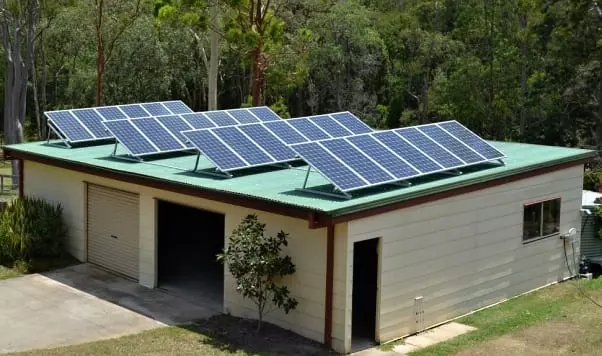Whether you're looking to install your own PV system or just interested in solar energy and systems then this article is for you. From start to finish I have detailed my whole solar installation experience including selecting an installer; equipment used; step-by-step installation coverage (with images); and any problems I, or the installation crew came across.
So my previous solar article on "Why I finally got a solar system" answered why I finally did end up getting a solar system, and this article is dedicated to explaining my whole solar install experience.
Even though I was very happy with my final price and overall solar package, there’s no doubt that a solar investment is still a lot of money (offset against electricity savings or not) and it’s a big decision for most people.

My 5kW PV System installed on shed roof (image above)
This is why the hunt for solar took me so long because I wanted to be convinced beyond doubt that not only was it the right decision, price, and time to get a PV system, but I also had the right solar company for the job. I needed to be confident the equipment used in my solar system (like the panels and inverter) was high quality and the installation crew were professional and not fly by the night con men.
Deciding on who to install your solar system
- Online reviews – these days a lot of peopl
 e document their retail experiences good and bad on the internet. There’s a good chance the solar company you are thinking of going with has some reviews about them online somewhere it’s just a matter of doing a search. There are even websites dedicated to solar company reviews and government sites showing accredited installers. Not all reviews online are credible though so be objective about what you read and just because a company has “five” stars, or “one” out of five it doesn’t necessarily mean one’s better than the other. Cross-matching reviews about the same company on several sites to get a full picture and the number of customers or people surveyed makes a big difference in how much you can trust online reviews.
e document their retail experiences good and bad on the internet. There’s a good chance the solar company you are thinking of going with has some reviews about them online somewhere it’s just a matter of doing a search. There are even websites dedicated to solar company reviews and government sites showing accredited installers. Not all reviews online are credible though so be objective about what you read and just because a company has “five” stars, or “one” out of five it doesn’t necessarily mean one’s better than the other. Cross-matching reviews about the same company on several sites to get a full picture and the number of customers or people surveyed makes a big difference in how much you can trust online reviews.
- Customer feedback – Sometimes a solar company’s own website will have a feedback page or a Facebook business page where you can see what their customers are asking and saying about them. Is the company replying to questions? How do they respond to both positive and negative feedback? Check their “about us” page and see how long they have been operating – if their website doesn’t answer this basic question and lacks basic information – be careful. You can learn about the company’s ethos through this method.
- Word of mouth – An oldie but a goodie, you can gauge a lot about a business by asking around locally. Perhaps you have a neighbour or resident nearby who has a PV system, if you do, ask them who they got to install it and are they happy with the outcome. Work colleagues, friends, and acquaintances – don’t be afraid to ask who has got solar, who with, why, and how is it going.
- Horse’s mouth – Talking to the solar company you're thinking of commissioning and their representatives is something people don’t do enough of. Getting to know your solar company or the sales rep is a very good way to see if the company is dodgy or professional. Remember, you should never be pressured into buying solar and a good solar company/rep will give you their time to explain and answer all your questions then let you walk away to think it over. In the meantime, you can have a relationship with your solar company for months whilst you decide – there’s no rush. Keep in contact with the rep and get updates on prices, etc and when you’re satisfied they are a good, stable, honest, and professional business then cut the deal.
- Equipment and subcontractors – In line with the point above, get to know what equipment the solar company uses; for example, do they use recognised quality panels and inverters or cheap ones? What is their warranty like? Can they produce examples of successful solar installs they have conducted? Do they install using their own people or do they subcontract out? If the solar company subcontracts who do they use and does the subcontracting company have a good reputation also?
Checking the credibility of your solar installer is definitely homework you need to do to ensure you sort out the flowers from the weeds and get the best PV system possible.
My solar installation (set-up, equipment, fees, charges, finance etc)
This next part of the article deals with the installation and practical costs associated with my solar system. Of course, my situation will be different from other solar installations but this information may be used as a guide to roughly compare fees and charges for anyone considering buying their own PV system.

Image above shows the proposed solar site being surveyed for the job
Size of home solar system
I decided to get the maximum size PV system allowed by our state regulations here in QLD which is 5kW (for a residential property) this includes 27 German made PV panels. If I was going to install solar, I wanted to make a real dent in my power bill not just wipe off a few dollars so I went as big as I could. On a good day, my system could produce up to 26 kW hours of electricity, on average about 20 – 22 kW hours per day.
The inverter has a 5kWcapacity (naturally) and is a Chinese made Samil Power SolarRiver series model, with an LCD screen showing power output accumulatively and in real time. Also, it has wireless capability so I can monitor the performance of the system via my PC or mobile phone – cool hey.

Here are the frames and brackets required for panels when the roof pitch/angle is not appropriate (image above)
Positioning of a roof solar system
However, it’s one thing to want a big system and another to have the roof capacity to support it. My house has an East/West aspect so the pitch of my roof doesn’t face North (which is the optimal direction panels should face getting the best sun benefit); therefore, if I installed solar panels on my house roof my panels wouldn’t work to the best capacity. Also, roof space for such a sized system would be an issue anyway.
How long did the solar installation take?

Halfway through fixing the panels to the frames – stage 3 (image above)
Who installed my rooftop solar system?
If you have read my previous solar articles you would guess which company I got to install my system – Green and Gold Solar, naturally. Obviously, I am very happy with how the whole process went from the site inspection and explanation to the quote, the install, and follow-up.
Were there any issues with solar PV install?
- ensuring the panels were angled correctly to take advantage of the sun;
- spacing the panels out across the roof so they wouldn’t shade each other;
- securing the frames to my wooden shed framework;
- wiring between all the panels;
- placement of the panels on the roof to avoid shading from large trees; and
- positioning the inverter on the inside door of the shed and making the electrical wiring job neat.

Solar PV system complete including the conduit to run the electrical wire between all panels (image above)
Apart from that, I had a medium sized gum tree right next to my shed on the western side which started to cast a shadow over ½ the building at around 2:00 PM. This would have had an effect on my PV systems output plus I was worried about branches and debris falling on the panels so I dropped the tree on the day before the install.
My costs and finance plan for our solar system
Also, my solar purchase was helped by a State Government lump-sum rebate of $1000, which was removed from the total overall cost and claimed back by the installer rather than me having to pay the extra grand and then claim it back myself from the Government.
 I didn’t want to pay cash outright for my solar system so I decided to opt for a finance plan offered by my solar company. Finance approval for my loan took 24 hours and wasn’t invasive at all, although, I did have to cough up $1000 for a deposit. And, due to the interest on the loan being calculated upfront, it was added to the overall cost and a monthly payment plan calculated. The whole finance deal was completely see-through.
I didn’t want to pay cash outright for my solar system so I decided to opt for a finance plan offered by my solar company. Finance approval for my loan took 24 hours and wasn’t invasive at all, although, I did have to cough up $1000 for a deposit. And, due to the interest on the loan being calculated upfront, it was added to the overall cost and a monthly payment plan calculated. The whole finance deal was completely see-through. Computer modeling was done on my specific situation using our average quarterly power bill, likely power generation, and feed-in tariff. After these variables were entered into the computer,the program showed my repayments for the loan to install my solar system would be canceled out by the savings I make through generating my own electricity. In other words, I would have been paying the same money (or more) over the next 12 months on electricity anyway, if I didn’t get a PV system.
Here is the actual Cost breakdown of my PV system (at the time) fully installed and covering everything including changing the metre box from dial to digital:
- Basic installation – $7,500 (with Government rebates);
- Extra for brackets and frames – $700;
- Interest/fees for borrowing on a finance plan over 2.5 years paid upfront – $1,800; and
- Total cost for full system = $10,000 (includes initial $1000 deposit)
# By disclosing my costs, I'm not implying the prices I paid (above) for my system and finance is the best on the market at the time – this is just meant to give people a guide.
Warranty of solar system
- Panels – 25 years;
- Inverter – 5 years; and
- Workmanship – 12 months.
How to know if my system is working correctly?
Once my system was installed the installation electrician gave me a “soldiers five” (rundown) on my whole system. He explained I should take the solar readings to ensure my system was performing as it should.
Checking the system daily for fluctuations is pointless because daily outputs can vary dramatically and be completely normal.
A solar system power output as described by the manufacturer is calculated over a full year; therefore, the system will not likely be outputting its maximum on a daily or seasonal basis (like through winter). If installed correctly and in a good position, collectively your system should meet its manufactures specified rating upon install over the 12 month period.


5kW inverter fixed to the wall inside the shed near the doorway (image above)
Conclusion
I have to say I am completely relieved to have my solar system installed and I’m eager to monitor how much of a difference our PV system will make to our electricity bills and usage. I’m glad my installation went well and I felt like I had done my homework to ensure I received the best price, equipment, and workmanship, possible at the time.
And that’s exactly how I feel about it. For a similar outlay, I would rather pay my own solar system off over 2.5 years (maybe less) than give it to some rich power company’s CEO and shareholders. In a few years, we’ll own our PV system outright and the tables will have turned from me getting ripped-off by my electricity provider to them paying me…
If you would like to make a comment about this article you can do so below in the comments section.

 e document their retail experiences good and bad on the internet. There’s a good chance the solar company you are thinking of going with has some reviews about them online somewhere it’s just a matter of doing a search. There are even websites dedicated to solar company reviews and government sites showing accredited installers. Not all reviews online are credible though so be objective about what you read and just because a company has “five” stars, or “one” out of five it doesn’t necessarily mean one’s better than the other. Cross-matching reviews about the same company on several sites to get a full picture and the number of customers or people surveyed makes a big difference in how much you can trust online reviews.
e document their retail experiences good and bad on the internet. There’s a good chance the solar company you are thinking of going with has some reviews about them online somewhere it’s just a matter of doing a search. There are even websites dedicated to solar company reviews and government sites showing accredited installers. Not all reviews online are credible though so be objective about what you read and just because a company has “five” stars, or “one” out of five it doesn’t necessarily mean one’s better than the other. Cross-matching reviews about the same company on several sites to get a full picture and the number of customers or people surveyed makes a big difference in how much you can trust online reviews.












